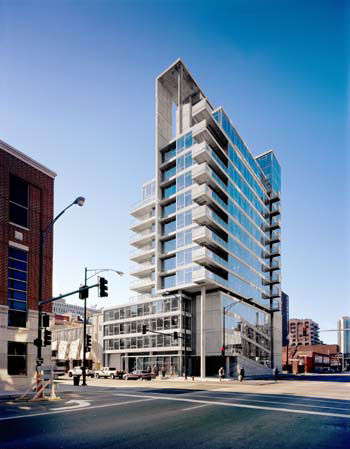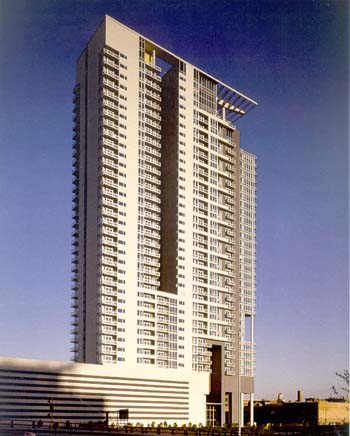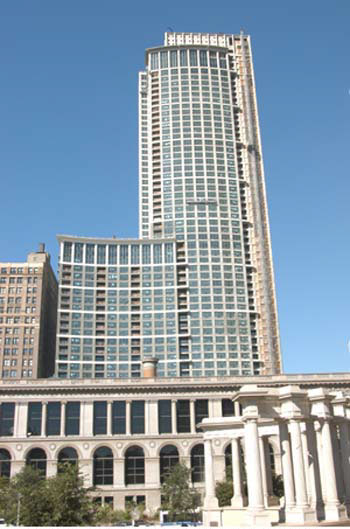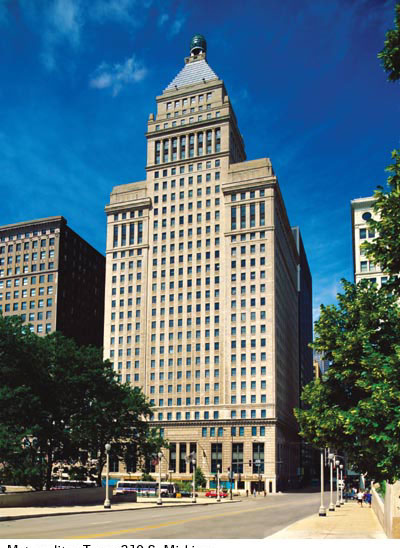Is thoughtful residential design gaining ground in Chicago?
 Few cities are more obsessed with themselves than Chicago, and Chicagoans obsess about few things more than their architecture. This, after all, is the birthplace of the highrise and some would argue, modern architecture itself. This is the town where Louis Sullivan, Frank Lloyd Wright and Mies van der Rohe all plied their trade and set standards for designers around the world. This is the home of some of the world’s greatest buildings and unfortunately, some of the ugliest.
Few cities are more obsessed with themselves than Chicago, and Chicagoans obsess about few things more than their architecture. This, after all, is the birthplace of the highrise and some would argue, modern architecture itself. This is the town where Louis Sullivan, Frank Lloyd Wright and Mies van der Rohe all plied their trade and set standards for designers around the world. This is the home of some of the world’s greatest buildings and unfortunately, some of the ugliest.
It’s on the latter that local media have focused of late, shocked into consciousness of the built environment by a decade-long construction boom that has produced its share of bland housing. Certainly its share, but it is easy to overlook, probably no more than its share.
 A 2003 cover story in the Chicago Reader (which Blair Kamin essentially rewrote a short time later in the Chicago Tribune), lamented the sorry state primarily of Chicago’s residential architecture during the ’90s and beyond. What, these stories wondered, has happened to the grand tradition of cutting-edge design that made Chicago an architectural Mecca in the late 19th and 20th centuries? How could we have let our standards slip so far?
A 2003 cover story in the Chicago Reader (which Blair Kamin essentially rewrote a short time later in the Chicago Tribune), lamented the sorry state primarily of Chicago’s residential architecture during the ’90s and beyond. What, these stories wondered, has happened to the grand tradition of cutting-edge design that made Chicago an architectural Mecca in the late 19th and 20th centuries? How could we have let our standards slip so far?
While it’s true that the current standards for residential architecture in the city are disappointingly low – most of what gets built is homogeneous and backward-looking without a hint of originality – are they really any lower than they’ve ever been? The critics seem to forget that the vast bulk of residential design in the ’60s and ’70s was mediocre at best. Has anyone driven up Sheridan Road lately or noticed the scourge of four-plus-ones that covers patches of the north lakefront? And let’s not forget that during the boom that followed the Great Chicago Fire, architects measured their work in miles of building fronts.
The fact is that most books written, songs sung, paintings painted and yes, buildings designed will be terrible. Nearly everything falls into the great mediocre middle. That mediocrity becomes painfully apparent when construction reaches the frenzied pace of recent years, but poor residential design is hardly a new phenomenon.
In fact, a small but growing number of residential projects, from in-fill townhouses to major highrises, have broken the pseudo-Victorian, ersatz deco, fake Second Empire and various other molds to introduce home buyers to fresh ideas. Developers such as Smithfield, CMK, Jack Berger and Optima have nurtured a contemporary aesthetic and built a track record for modern design in Chicago.
Start counting up the current and recent projects with interesting design, developments like Trump Tower, 30 W. Oak, Erie on the Park, River Bend, Park Place, Wells Street Tower, Skybridge, Contemporaine, the Heritage at Millennium Park, a host of adaptive reuse developments and others, and the zeitgeist starts to look comparatively good.
 In a crowded market, some developers say, it’s become more important than ever to stand out, and innovative architecture is one way to separate yourself from the crowd. Financing projects with modern designs has become easier now that the market has proven they can sell, and while most buyers still may prefer something that looks like grandma’s house, the public seems to be increasingly aware and accepting of progressive architecture.
In a crowded market, some developers say, it’s become more important than ever to stand out, and innovative architecture is one way to separate yourself from the crowd. Financing projects with modern designs has become easier now that the market has proven they can sell, and while most buyers still may prefer something that looks like grandma’s house, the public seems to be increasingly aware and accepting of progressive architecture.
 In a positive sign for Chicago, one of the more interesting developments on the drawing board is both one of the biggest and a replacement for an exceptionally ugly building in a very prominent place. At 90 stories, Trump Tower will be the fourth tallest building in the city when complete. It replaces the decrepit Sun-Times building, which would have looked more at home on the banks of the Mississippi in some depressed burg than on a prime piece of Chicago riverfront, on the edge of the Loop next to the pristine Wrigley Building and the gothic flourishes of the Tribune Tower.
In a positive sign for Chicago, one of the more interesting developments on the drawing board is both one of the biggest and a replacement for an exceptionally ugly building in a very prominent place. At 90 stories, Trump Tower will be the fourth tallest building in the city when complete. It replaces the decrepit Sun-Times building, which would have looked more at home on the banks of the Mississippi in some depressed burg than on a prime piece of Chicago riverfront, on the edge of the Loop next to the pristine Wrigley Building and the gothic flourishes of the Tribune Tower.
Replacing the tin shack of the Sun-Times is a sleek highrise of glass and stainless steel designed by Adrian Smith of Skidmore Owings & Merrill. The project continues the city’s newfound respect for the Chicago River, with an expanded arcade that will link Michigan Avenue to Wabash and bring new life to what should be a bustling location. The building’s imposing height is softened by a segmented design that offers a series of setbacks, each with a rounded corner. It’s a design idea reminiscent of another soaring Skidmore building, the Sears Tower, though here its execution is much more graceful and visually interesting.
Trump is obviously an outsider, but Smithfield Properties is a local developer that consistently makes progressive design a priority in its developments. The latest, 30 W. Oak, will rise 22 stories in a truly original residential design. The facade curves at a surprisingly strong but graceful angle that will make a bold statement from the street and inside, create spaces much more interesting than the typical boxy condo floor plans. Instead of the usual balconies, which are too small to be of much use but big enough to ruin a building’s pro file, the end units at 30 W. Oak were designed with capacious terraces – highly functional, organic spaces that seem an integral element of the building, not addenda. The beautifully modern design has a strong horizontal emphasis that reveals the building’s skeleton in grand Chicago style.
Trump Tower and 30 W. Oak have yet to break ground, but a couple of other gems recently have been completed. The unusual design for Skybridge, 1 N. Halsted, by Ralph Johnson, of Perkins & Will, sought to avoid dropping a giant curtain of a building on the edge of the West Loop, a neighborhood of low-rise lofts. Instead, Johnson broke up the structure, which feels like three buildings in one, artfully connected by a glass cutout and a steel sculptural element (a bridge of sorts) that caps the 39-story tower like a giant overhanging trellis. A series of glass-enclosed walkways connect what look like two distinct towers and provide a transparent look at the life of the building and the skyline beyond it.
 River Bend, designed by Robert Bistry, of DeStefano & Partners, has a very different look, but it too grows organically from its site, Wolf Point, where the river bends at the confluence of its north, south and main branches. The 38-story tower gracefully mimics that bend and because of a relatively narrow floor plate, it was conceived as single-loaded corridor design. That means that all residents have an east-facing view of the river and skyline while from the west, the city looks at a face whose neat horizontal bands warmly punctuated by uniform interior lights makes for a great addition to the nighttime skyline
River Bend, designed by Robert Bistry, of DeStefano & Partners, has a very different look, but it too grows organically from its site, Wolf Point, where the river bends at the confluence of its north, south and main branches. The 38-story tower gracefully mimics that bend and because of a relatively narrow floor plate, it was conceived as single-loaded corridor design. That means that all residents have an east-facing view of the river and skyline while from the west, the city looks at a face whose neat horizontal bands warmly punctuated by uniform interior lights makes for a great addition to the nighttime skyline
Skybridge and River Bend have both sold slower than expected, but in neither case was architecture a factor. Mesa’s Heritage at Millennium Park – a beautifully beveled design of glass and limestone by Solomon Cordwell Buenz & Associates – is proof that modern sells. At press time, the highrise had only three units remaining for sale.
A number of architecturally interesting adaptive reuse projects also are underway. These include Metropolis, the conversion of the 1913 “commercial gothic” North American Building, by Holabird & Roche, at 8 W. Monroe; and the similarly named Metropolitan Tower, the conversion of the 1924 Strauss Building by Graham, Anderson, Probst & White. Metropolitan Tower will be recognizable to many Chicagoans for its trademark pyramid roof capped with a glass beehive, which originally housed a beacon and was meant to symbolize the company’s global reach.
Is all of today’s prominent residential architecture in Chicago high-quality, progressive or even interesting? No. The vast bulk of it, like the vast bulk of anything, remains bland. But progressive residential design gained a new foothold in the building boom of the ’90s, and while the number of thoughtful buildings will never make a majority, it appears to be headed in the right direction.
